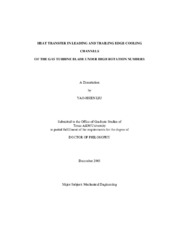| dc.description.abstract | The gas turbine blade/vane internal cooling is achieved by circulating the
compressed air through the cooling passages inside the turbine blade. Leading edge and
trailing edge of the turbine blade are two critical regions which need to be properly
cooled. Leading edge region receives extremely hot mainstream flow and high heat
transfer enhancement is required. Trailing edge region usually has narrow shaped
geometry and applicable cooling techniques are restricted. Heat transfer will be
investigated in the leading edge and trailing edge cooling channels at high rotation
numbers close to the engine condition.
Heat transfer and pressure drop has been investigated in an equilateral triangular
channel (Dh=1.83cm) to simulate the cooling channel near the leading edge of the gas
turbine blade. Three different rib configurations (45°, inverted 45°, and 90°) were tested
at four different Reynolds numbers (10000-40000), each with five different rotational
speeds (0-400 rpm). By varying the Reynolds numbers (10000-40000) and the rotational
speeds (0-400 rpm), the rotation number and buoyancy parameter reached in this study were 0-0.58 and 0-2.3, respectively. 45° angled ribs show the highest thermal
performance at stationary condition. 90° ribs have the highest thermal performance at the
highest rotation number of 0.58.
Heat transfer coefficients are also experimentally measured in a wedge-shaped
cooling channel (Dh =2.22cm, Ac=7.62cm2) to model an internal cooling passage near
the trailing edge of a gas turbine blade where the coolant discharges through the slot to
the mainstream flow. Tapered ribs are put on the leading and trailing surfaces with an
angle of attack of 45°. The ribs are parallel with staggered arrangement on opposite
walls. The inlet Reynolds number of the coolant varies from 10,000 to 40,000 and the
rotational speeds varies from 0 to 500 rpm. The inlet rotation number is from 0 - 1.0.
The local rotation number and buoyancy parameter are determined by the rotational
speeds and the local Reynolds number at each region. Results show that heat transfer is
high near the regions where strong slot ejection exists. Both the rotation number and
buoyancy parameter have been correlated to predict the rotational heat transfer
enhancement. | en |


